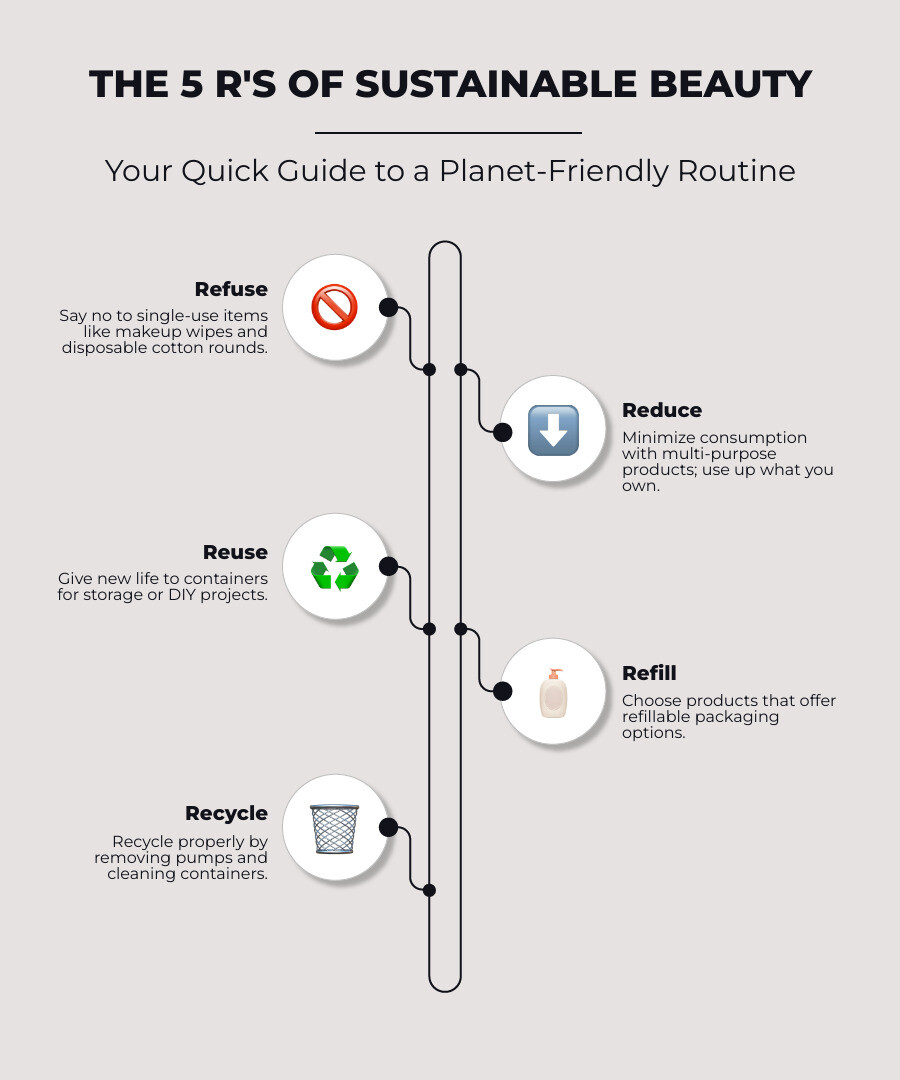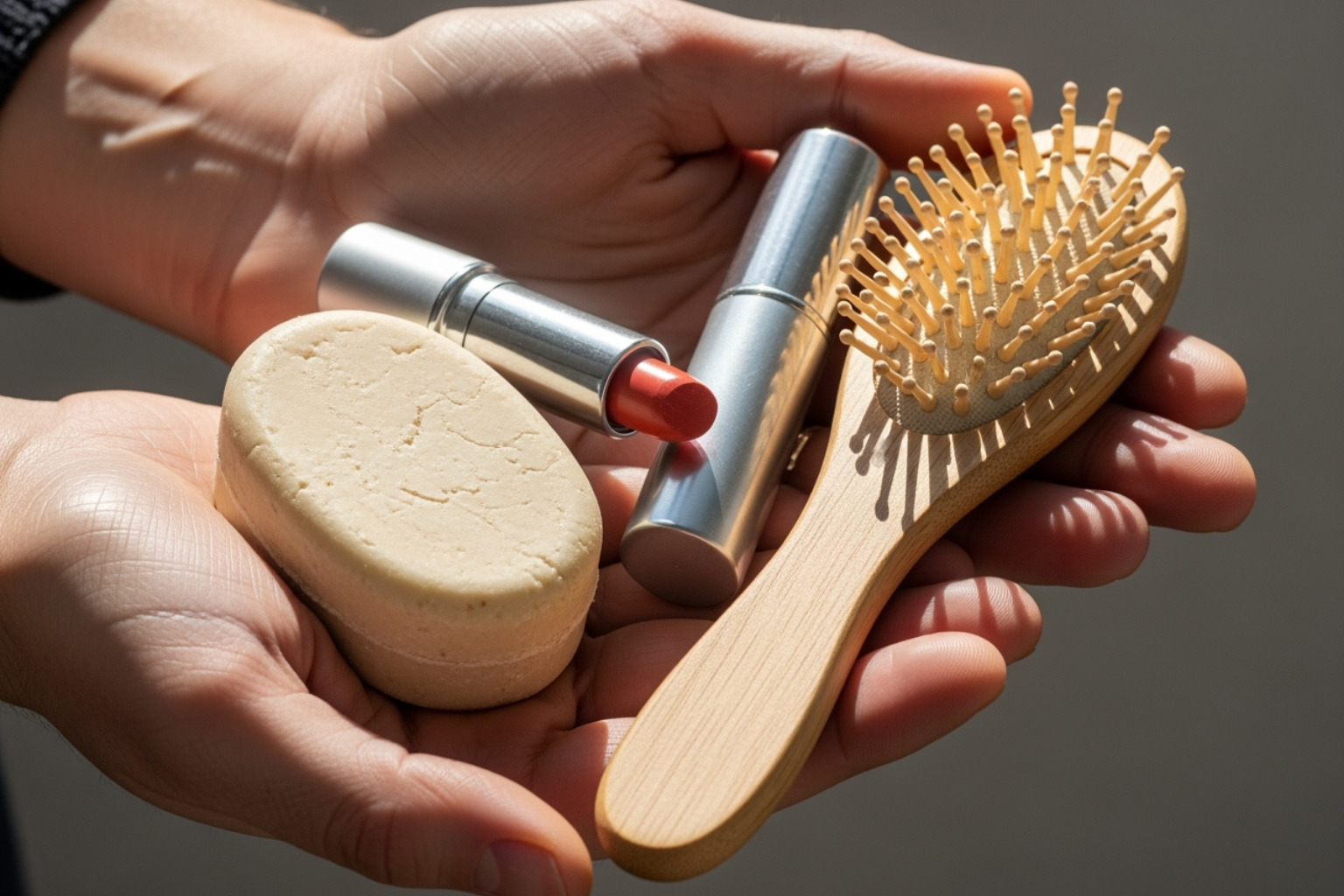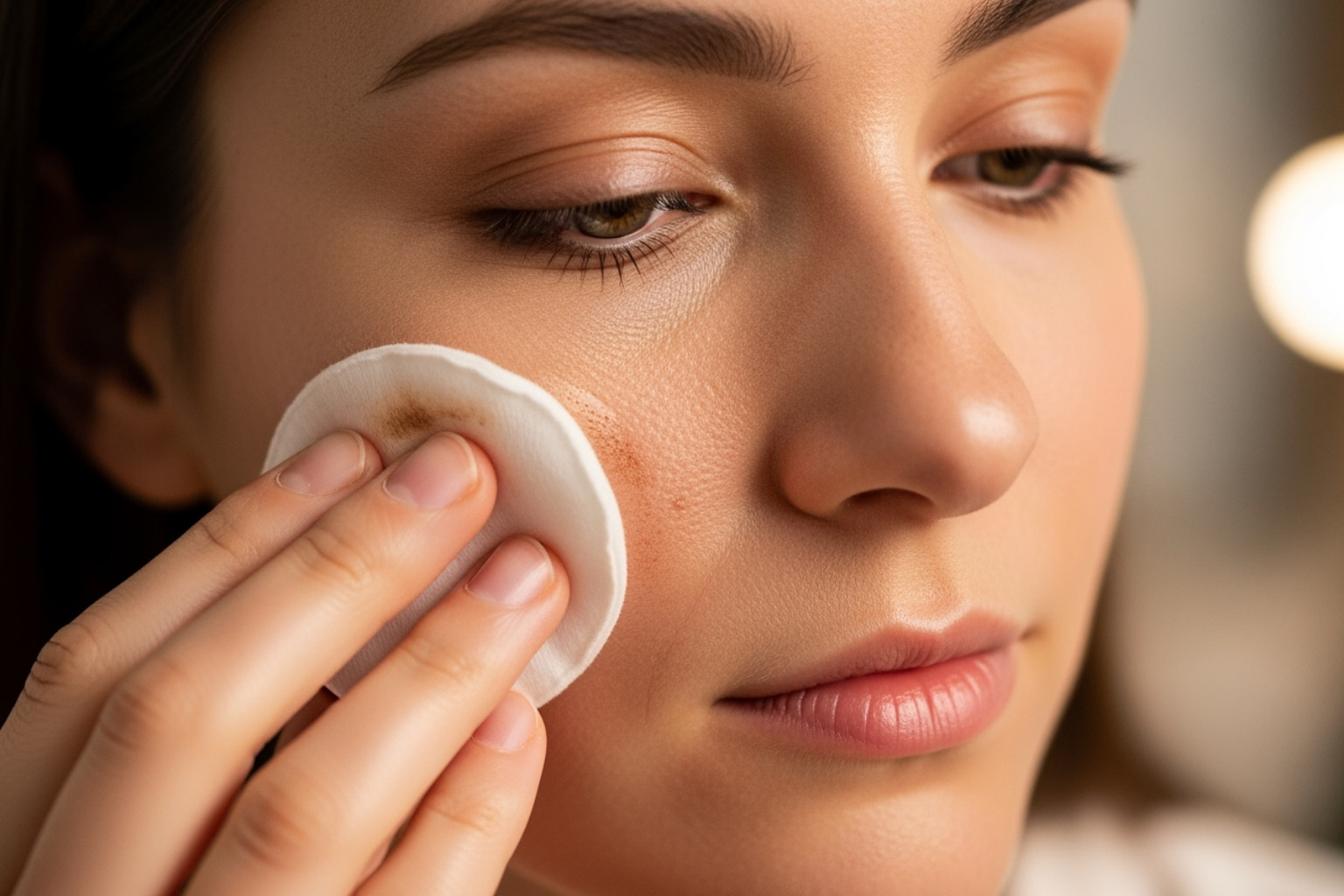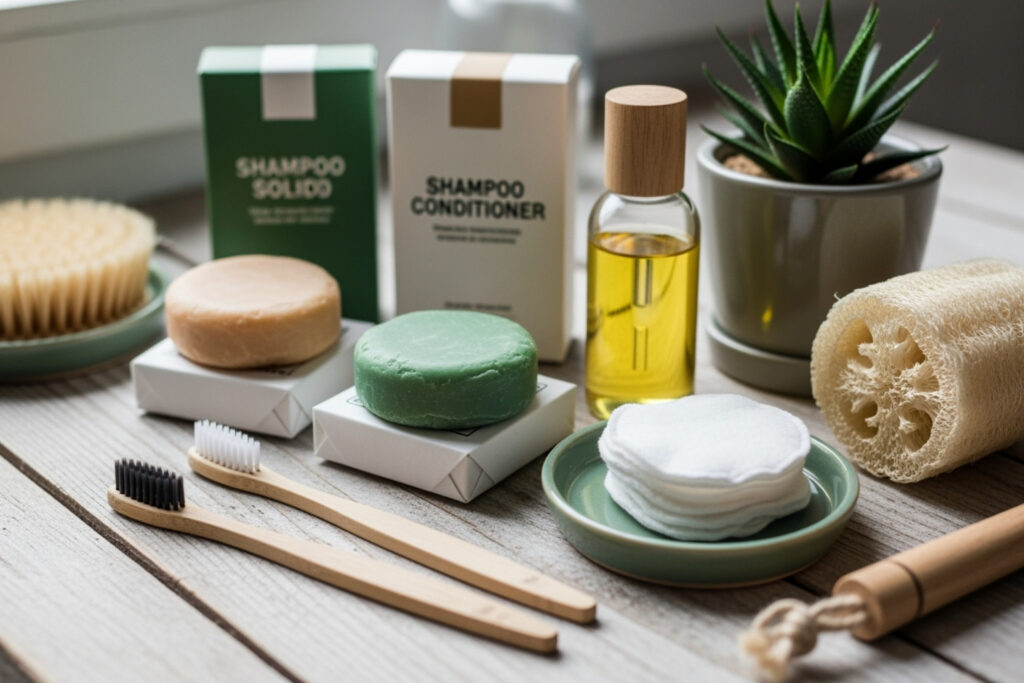Why Your Beauty Routine Needs a Planet-Friendly Makeover
A sustainable beauty routine transforms your daily self-care habits into choices that benefit both your skin and the environment. Here’s what you need to know:
Quick Guide to Sustainable Beauty:
- Refuse single-use items like makeup wipes and disposable cotton rounds
- Reduce consumption by using multi-purpose products and finishing what you own
- Reuse containers for storage or DIY projects
- Refill products when brands offer refillable packaging options
- Recycle properly by removing pumps and cleaning containers
Your bathroom routine creates more environmental impact than you might realize. The beauty industry produces over 152 billion units of packaging globally each year, with most ending up in landfills. Face wipes alone take up to 100 years to decompose, while microbeads from scrubs harm marine life.
But here’s the good news: small changes in your daily routine can create meaningful impact. You don’t need to overhaul everything overnight or fit your yearly waste into a mason jar. Simple swaps like switching to bar soap, using reusable cotton rounds, or choosing products with recyclable packaging make a real difference.
The climate crisis demands action, and your beauty choices matter more than you think. When you vote with your wallet for sustainable brands and practices, you’re helping shift an entire industry toward better alternatives.

Explore more about sustainable beauty routine:
The Unseen Cost of Beauty: Why Sustainability Matters
Every morning, as you reach for your favorite serum or mascara, there’s an invisible story unfolding. Behind that perfect packaging and silky formula lies a complex web of environmental impacts that most of us never see. The beauty industry, while bringing us joy and confidence, also carries a hefty environmental price tag.
Understanding these hidden costs isn’t meant to make you feel guilty about your skincare ritual. Instead, it’s about making informed choices that help you build a truly sustainable beauty routine that works for both you and the planet.
The Packaging Problem
Walk into any beauty store, and you’ll be surrounded by gorgeous packaging. Sleek bottles, colorful tubes, and neat compacts line the shelves. But here’s what’s happening behind the scenes: the beauty and personal care industry created almost 8 billion rigid plastic packaging units in a single major market during 2018.
Globally, we’re talking about 152.1 billion units of beauty packaging sold in just one year. To put that in perspective, if you stacked all those containers, you’d have towers reaching far beyond the clouds. Most of this packaging will never see the inside of a recycling facility.
The recycling challenge runs deeper than you might think. That beautiful pump bottle sitting on your vanity? The pump mechanism contains mixed materials – plastic, metal springs, and rubber components that can’t be separated easily. Even if the glass bottle itself is perfectly recyclable, the entire product often ends up in the trash because of that one complex component.
Single-use items create an even bigger headache. Those convenient makeup wipes that save you time after a long day? They’ll stick around in landfills for up to 100 years after you’ve tossed them. It’s a sobering thought when you consider how briefly they actually serve their purpose.
The Ingredient Issue
The packaging is just part of the story. The ingredients inside our beloved products can create their own environmental ripple effects, often in ways we never consider.
Remember microbeads? Those tiny plastic particles that used to give face scrubs their gritty texture seemed harmless enough in the tube. But every time you washed your face, thousands of these microscopic plastics swirled down the drain, through water treatment plants, and straight into our oceans. Marine life mistook them for food, and they worked their way up the entire food chain. Thankfully, most countries have banned microbeads, but it took years to recognize the damage they were causing.
Chemical runoff presents another invisible challenge. When you rinse off your cleanser or shampoo, where do you think those ingredients go? Many end up in waterways, where they can disrupt aquatic ecosystems and contaminate drinking water sources.
The sourcing story gets even more complex when you dig deeper. That gorgeous shimmer in your eyeshadow? It often comes from mica, a mineral that’s been linked to child labor and dangerous mining conditions in some regions. While brands are increasingly turning to synthetic alternatives, it highlights why transparency in supply chains matters so much.
Even seemingly innocent ingredients like palm oil can carry environmental baggage. Palm plantations have contributed to massive deforestation in some of the world’s most biodiverse regions. Then there’s water consumption – both in manufacturing products and in our daily use of them.
The good news? By understanding these impacts, you can make choices that align with your values. A sustainable beauty routine isn’t about perfection; it’s about being mindful of these connections and choosing better options when they’re available.
The Core Principles of a Sustainable Beauty Routine
Building a sustainable beauty routine isn’t just about swapping one product for another. It’s about embracing a completely different approach to beauty that puts both your wellbeing and the planet’s health at the center of every decision.

Think of it as a three-legged stool: mindful consumption, conscious ingredients, and eco-friendly packaging. When all three work together, you create a routine that’s not only better for the environment but often more effective and satisfying for you too.
Mindful Consumption: Less is More
Here’s a truth that might surprise you: the most sustainable product is the one you already own. Before you reach for that tempting new serum or trendy cleanser, take a moment to use up what you have first. It sounds simple, but it’s in a world that constantly pushes us toward the next big thing.
Multi-purpose products are your secret weapon here. That tinted balm that works on both lips and cheeks? The facial oil that doubles as a body moisturizer? These heroes of efficiency reduce clutter, save money, and cut down on packaging waste all at once.
Minimalist skincare doesn’t mean boring skincare. It means being intentional about what you use and resisting trends that don’t serve your skin’s actual needs. Your skin will thank you for the consistency, and your bathroom cabinet will thank you for the space.
Conscious Ingredients: Clean & Green
What goes into your products matters just as much as what contains them. Natural ingredients and biodegradable formulas work in harmony with your skin’s natural processes while breaking down safely when they wash down the drain.
Waterless products like solid shampoo bars and cleansing balms are game-changers. They concentrate the good stuff while eliminating the need for water in formulations, often coming in minimal or plastic-free packaging too.
When you choose cruelty-free and vegan options, you’re supporting brands that align with ethical values. Plant-based skincare offers powerful botanicals that have been nourishing skin for centuries, often with a gentler environmental footprint than their synthetic counterparts.
Eco-Friendly Packaging: Rethink the Wrap
This is where innovation meets necessity. The packaging revolution in beauty is happening right now, and you get to be part of it by voting with your wallet.
Refillable options are the ultimate in sustainable luxury. Imagine keeping that beautiful glass bottle forever and just replacing the inner contents. Many forward-thinking brands now offer refill pouches that use up to 85% less packaging than buying new.
Glass containers and aluminum packaging aren’t just prettier – they’re infinitely recyclable. Unlike plastic, which degrades each time it’s recycled, these materials maintain their quality through countless cycles.
Post-consumer recycled materials give plastic waste a second life, while compostable packaging made from plant-based materials returns to the earth safely. And then there are naked products – shampoo bars, solid deodorants, and cleansing balms that need nothing more than a simple paper wrapper.
The beauty of building a sustainable beauty routine around these principles is that they work together. Less consumption means fewer harsh ingredients touching your skin. Better packaging often signals better formulations. It’s a positive cycle that benefits everyone involved – including you.
Your Step-by-Step Guide to an Eco-Friendly Routine
Ready to transform your daily beauty habits into a more planet-friendly routine? Creating a sustainable beauty routine doesn’t require a complete overhaul overnight. Instead, it’s about making thoughtful swaps and developing new habits that become second nature over time.

The beauty of going eco-friendly is that most changes actually improve your routine while helping the planet. You’ll save money, reduce clutter, and often end up with products that work better for your skin. Let’s explore the practical steps that make the biggest difference.
How to Reduce Waste in Your Sustainable Beauty Routine
The easiest wins in sustainable beauty come from simple swaps that eliminate single-use items. Ditching face wipes is probably the most impactful change you can make. These convenient but wasteful products are terrible for both your skin and the environment. Replace them with a soft flannel cloth and cleansing balm – your skin will thank you for the gentler treatment.
Reusable cotton rounds are another game-changer. These soft, washable rounds can be tossed in with your regular laundry and used hundreds of times. They’re more effective than disposable cotton balls and feel luxurious against your skin.
If you shave regularly, consider investing in a safety razor. While the upfront cost is higher, you’ll save money in the long run since replacement blades cost pennies compared to disposable razors. Plus, you’ll eliminate mountains of plastic waste from your routine.
Reusable tools like bamboo makeup brushes and washable makeup removal pads last for years with proper care. They often perform better than disposable alternatives and add a spa-like feel to your routine.
When products run out, don’t automatically toss the containers. Upcycling containers gives them a second life – those pretty glass jars make perfect storage for homemade scrubs, small accessories, or even mini planters for your windowsill.
For containers you can’t reuse, proper recycling makes a difference. Remove pumps and caps since they’re often made of mixed materials that contaminate recycling streams. Clean containers thoroughly and check your local guidelines for specific requirements.
Water-Wise Habits
Water conservation might not be the first thing you think about with beauty routines, but it’s surprisingly impactful. The simple act of turning off the tap while applying cleanser, brushing teeth, or doing your skincare routine can save gallons of water each month.
Waterless formulas are becoming incredibly sophisticated and effective. Solid shampoo and conditioner bars eliminate plastic bottles entirely while often lasting longer than liquid versions. These concentrated formulas travel well and create a rich, luxurious lather.
Cleansing balms are another water-wise choice. These rich, oil-based cleansers melt away makeup and impurities without requiring multiple rinses. They’re particularly effective for removing stubborn makeup while being gentler on your skin than harsh cleansing wipes.
DIY Beauty: The Ultimate Customization
Making your own beauty products gives you complete control over ingredients and packaging. It’s also surprisingly fun and creative. You don’t need to become a chemist – start with simple recipes using ingredients you probably already have.
Body butter is incredibly easy to make. Combine shea butter with coconut oil and your favorite carrier oil like jojoba or sweet almond oil. Whip it together for a rich, nourishing moisturizer that rivals expensive store-bought versions. Store it in a repurposed glass jar for zero packaging waste.
Sugar scrubs require just two ingredients: sugar and oil. Add a few drops of essential oil for fragrance, and you have a gentle exfoliant that’s completely customizable to your preferences. Olive oil works beautifully for a budget-friendly option.
Buying bulk ingredients like essential oils, carrier oils, and natural butters reduces packaging waste while saving money. Store them in glass containers with tight lids, and they’ll last for months. Mason jars are perfect for storing finished DIY products and ingredients alike.
Creating your own products connects you to your routine in a deeper way. You know exactly what’s going on your skin, and there’s something deeply satisfying about using something you made yourself. Plus, homemade products make wonderful gifts for friends who are also interested in sustainable living.
Becoming a Conscious Consumer: How to Choose Sustainable Beauty

Shopping for sustainable beauty can feel like navigating a maze. With so many brands jumping on the eco-friendly bandwagon, it’s challenging to separate genuine commitment from clever marketing. The good news? Once you know what to look for, building an authentic sustainable beauty routine becomes much easier.
Decoding Labels and Certifications
Think of certifications as your personal shopping assistants. They’ve done the hard work of verifying claims so you don’t have to spend hours researching every brand. These trusted symbols are worth looking for on your next shopping trip.
Leaping Bunny certification means no animals were harmed in making your products – not during ingredient testing, not during product development, not ever. It’s the gold standard for cruelty-free beauty.
When you see Certified B Corp, you’re looking at a company that has passed rigorous evaluations of their social and environmental impact. These businesses are legally required to balance profit with purpose, making them reliable partners in your sustainability journey.
EWG Verified products have been thoroughly screened to avoid ingredients of concern. If you’re someone who gets overwhelmed reading ingredient lists, this certification does the heavy lifting for you.
Organic certifications like USDA Organic, Soil Association Organic, Ecocert, or COSMOS ensure that ingredients meet strict environmental and health standards. These aren’t just marketing terms – they represent real oversight and accountability.
Fair Trade certification tells you that the people who grew and harvested your ingredients received fair wages and worked in safe conditions. It’s a reminder that sustainability includes social responsibility.
How to Spot and Avoid Greenwashing
Here’s the reality: some brands are more interested in appearing green than actually being green. This practice, called greenwashing, can make conscious shopping frustrating. But once you know the warning signs, you’ll spot it easily.
Watch out for vague language like “natural” or “eco-friendly” without any specifics. These terms sound good but don’t actually tell you anything concrete about the product’s environmental impact.
Pretty packaging with leaves, earth tones, or nature imagery doesn’t automatically mean a product is sustainable. Some of the least eco-friendly products come wrapped in the most convincing green marketing.
Truly sustainable brands are transparent about their practices. They’ll tell you where ingredients come from, how products are made, and what their environmental impact looks like. If you have to dig deep to find this information – or can’t find it at all – that’s a red flag.
Be skeptical when a brand highlights just one green attribute while ignoring everything else. A product might be “ocean-safe” but still come in non-recyclable packaging or be made by a company with questionable labor practices.
The best defense against greenwashing? Do a little homework. Beyond Beauty Lab provides resources to help you research brands and make informed choices for your sustainable beauty routine.
Making Your Sustainable Beauty Routine Affordable
Let’s address the elephant in the room: sustainable beauty can seem expensive. While some ethical brands do cost more upfront, there are plenty of ways to build an eco-friendly routine without breaking your budget.
DIY beauty is your secret weapon for affordable sustainability. Making your own body butter, face masks, or sugar scrubs costs a fraction of store-bought versions and gives you complete control over ingredients. Plus, you can buy ingredients in bulk and store them in reusable containers.
Multi-purpose products are budget heroes. A high-quality oil that works for your face, body, and hair might cost more than a single-use product, but it replaces three separate purchases. The math works in your favor.
Focus on essentials rather than trying to replace everything at once. Invest in sustainable versions of the products you use daily – cleanser, moisturizer, sunscreen – before worrying about specialty items you use occasionally.
Many brands now offer refillable options that reduce cost per use over time. The initial investment might be higher, but you’ll save money on future purchases while dramatically reducing packaging waste.
Clean beauty on a budget is absolutely achievable. Start small, prioritize the products that matter most to you, and build your sustainable routine gradually. Your wallet and the planet will thank you.
Frequently Asked Questions about Sustainable Beauty
Starting your sustainable beauty routine journey can feel overwhelming at first. We hear the same thoughtful questions from our community all the time, and honestly, they’re exactly the questions we asked ourselves when we began this path. Let’s explore the answers together.
What is the single most impactful change I can make?
Here’s the truth that might surprise you: the most powerful thing you can do is simply use less. Before you rush out to buy eco-friendly replacements for everything in your bathroom, take a moment to use up what you already own.
This approach works because it tackles the root of the problem. Every product you don’t buy means less demand for new manufacturing, less packaging waste, and fewer resources consumed. When you do need to replace something, that’s when you make the switch to multi-purpose products that do double duty or refillable packaging options that you can use again and again.
It’s not as glamorous as a complete bathroom makeover, but reducing consumption creates the biggest ripple effect in shifting our beauty habits toward sustainability.
Are sustainable beauty products as effective?
This question always makes us smile because the answer is a resounding yes! The effectiveness of any beauty product comes down to formulation quality, not whether it comes in recyclable packaging or uses organic ingredients.
Many sustainable brands are actually leading the charge in scientific innovation. They’re combining time-tested natural ingredients with cutting-edge research to create formulas that are both powerful and gentle. Think about it: plants have been solving skin problems for thousands of years, and now we have the science to understand exactly why certain botanical ingredients work so well.
The key is finding what works for your skin type. You might need to do some patch testing and experimentation, just like you would with any new product. But once you find your sustainable favorites, you’ll often find they’re more concentrated and nutrient-rich than their conventional counterparts.
Can one person’s routine really make a difference?
We get it. When you’re standing in your bathroom holding a single shampoo bar, it’s hard to imagine how this tiny choice could matter in the face of massive environmental challenges. But here’s what we’ve learned: individual actions create collective impact.
Every time you choose a sustainable product, you’re casting a vote with your wallet. You’re telling brands that consumers want better options, cleaner ingredients, and responsible packaging. This sends market signals that encourage more companies to invest in sustainable innovation and adopt ethical practices.
Your choices also have a beautiful way of inspiring others. When friends notice your gorgeous glass bottles or ask about your amazing skin, you become a walking advertisement for sustainable beauty. You’re not just reducing your own environmental footprint; you’re helping to normalize these choices for everyone around you.
The truth is, movements start with individuals who decide to do things differently. Your sustainable beauty routine is part of a growing wave of conscious consumers who are reshaping an entire industry, one bathroom cabinet at a time.
Conclusion
Your journey toward a sustainable beauty routine doesn’t end here – it’s really just beginning. Think of it as a gentle evolution rather than a dramatic overnight change. Every small choice you make, from finishing that half-empty moisturizer before buying a new one to choosing a refillable lipstick, creates ripples of positive change that extend far beyond your bathroom counter.
We’ve walked through the eye-opening realities of beauty’s environmental impact, from those staggering packaging statistics to the hidden costs of certain ingredients. But more importantly, we’ve finded that sustainable beauty isn’t about sacrifice – it’s about making thoughtful choices that often work better for both your skin and your wallet.
The core principles we’ve explored – mindful consumption, conscious ingredients, and eco-friendly packaging – aren’t rigid rules to follow perfectly. They’re gentle guidelines to help you steer this beautiful, sometimes overwhelming world of sustainable options. Whether you start with simple swaps like reusable cotton rounds, dive into the fun world of DIY body butters, or become a label-reading detective who can spot greenwashing from a mile away, you’re making a difference.
There’s no such thing as a perfect sustainable beauty routine. What matters is progress, not perfection. Your planet-friendly glow comes from the confidence of knowing that your choices align with your values, creating a ripple effect that inspires others to make conscious decisions too.
At Beyond Beauty Lab, we’re here to support your journey with educational content and wellness insights that help you make informed choices. We believe that when you understand the ‘why’ behind sustainable beauty, the ‘how’ becomes so much easier and more meaningful.
Ready to take the next step? Explore our recommended Sustainable Beauty Products and continue growing your knowledge with us. Your skin, your wallet, and our beautiful planet will thank you for it.







